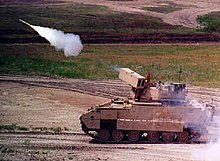M6 linebacker
The M6 Linebacker was a United States Army anti-aircraft tank based on the M2 Bradley ODS (M2A2 ODS). It was introduced from the 1990s. Its mission is the air defense at close range ( English Short-range Air Defense (SHORAD) ) mechanized infantry - and armored divisions . The name is taken from the terminology of American football and describes a defensive playing position in the second row.
The M6 Linebacker is based on the M2 Bradley ODS (M2A2 ODS). The TOW launch tubes of the Bradley were replaced by a FIM-92 Stinger launch container and the target acquisition and other electronics were adapted to the new task. The target acquisition is computer-aided and works up to a driving speed of approx. 40 km / h. The cost of the system is much less than a completely new design because of the use of many parts of the Bradley IFV. This also simplifies the supply of spare parts and maintenance of the vehicles.
The M6 Linebacker is intended to fight cruise missiles , helicopters , drones and conventional aircraft in close proximity to its own allies and thus protect them from attacks from the air. The M6 is dependent on tank support, as it is vulnerable to attacks due to the lack of effective anti-tank weapons. The M6 is just as fast and agile as the Bradley on which it is based and can therefore easily keep up with its own armored forces.
Target data are supplied by forward area air defense (FAAD) observers and the on-board systems (C3I, IFF etc.). The stinger missiles can be fired on the move and without a crew member having to leave the tank. The launch container attached to the tower holds four stinger missiles and another six can be carried in the vehicle. To reload, however, the crew must leave the tank. Conventional Bradleys can also carry up to six stingers, which are either fired from shoulder launchers by infantrymen or passed on to linebackers.
In addition to the Stingerraketen, the linebacker, a 25-mm automatic cannon and a 7.62 mm machine gun . These weapons, originally planned for self-defense, can also be used effectively against air targets using an improved laser target range finder.
For self-protection against enemy anti-tank missiles , the linebacker is equipped with a Missile Countermeasure Device (MCD) , which tries to blind the target acquisition of approaching anti-tank missiles with strong infrared radiation. However, this system only works for the tank itself and cannot protect other vehicles.
The next generation of linebackers, based on the M2A3, should have improved target acquisition and improved self-protection. The plan was to increase the hit rate by 140 percent and reduce your own losses by 30 percent.
The M6 linebacker was manufactured by United Defense and Boeing under the supervision of the Bradley program and the Fort Bliss SHORAD program. 107 vehicles were ordered.
Due to restructuring, the linebackers have become superfluous and have now been completely restored to normal M2.
See also
- List of tank models after 1945
- Gepard anti-aircraft cannon tank
- 2K22 Tunguska
- Weasel 2 ocelot
- Skyguard
- Anti-aircraft gun
Web links
Individual evidence
- ↑ Page 8 the reference to the Linebaker ( Memento from March 6, 2009 in the Internet Archive )
literature
- Bradley M2 / M3 Tracked Armored Fighting Vehicles, USA.
- Cooke, Gary W. "M2 Bradley Fighting Vehicle".
- "M2 / M3 Bradley Fighting Vehicles". Military Suppliers and News.
- "US Army Awards Bradley Conversion Kits Contract to BAE". army-technology.com. 3 December 2010.
- Michael Green & James D. Brown (2007). M2 / M3 Bradley at War. St. Paul, MN: Zenith Press. ISBN 978-0-7603-2523-0 .
- Haworth, W. Blair (1999). The Bradley and How It Got That Way: Technology, Institutions, and the Problem of Mechanized Infantry in the United States Army. Westport, Conn .: Greenwood Press. ISBN 0-313-30974-4 .
- "Vehicle to Honor Bradley". The New York Times. Associated Press. 18 October 1981.
- Burton, James G. The Pentagon Wars: Reformers Challenge the Old Guard (Annapolis, MD: Naval Institute Press, 1993), ISBN 1-55750-081-9 .
- Diane L. Urbina. "Lethal beyond all expectations: The Bradley Fighting Vehicle" —in chapter 12 of George F. Hofmann and Donn A. Starry (editors) Camp Colt to Desert Storm: The History of US Armored Forces, Lexington, Kentucky; The University Press of Kentucky, ISBN 0-8131-2130-2 .
- AC Colletti (March 31, 1983). "2 AD Combat Unit Receives Bradleys". Fort Hood Sentinel.
- "FMC Gets New Bradley Fighting Vehicle Contract". Associated Press. July 7, 1988.
- "M2A3 and M3A3 Bradley Fighting Vehicle Systems (BFVS)". Federation of American Scientists. May 5, 2000.
- "M2 and M3 Bradley Fighting Vehicle Systems (BFVS)". Global Security. 20 October 2018.
- LB Thompson, LJ Korb, CP Wadhams. Army Equipment After Iraq Lexington Institute and Center for American Progress .
- Tank 2022: Demos & Decisions For Army's next Generation Combat Vehicle Breakingdefense.com .


